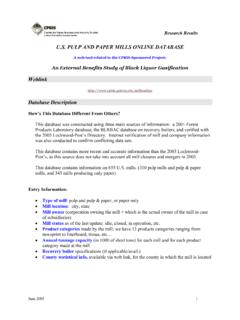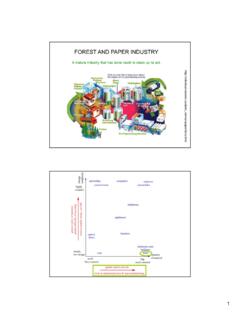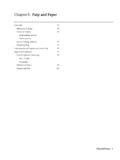Transcription of STUDIES ON BENCHMARKING /INPUT NORMS FOR PULP …
1 1 REPORT ON STUDIES ON BENCHMARKING / input NORMS FOR pulp AND paper industry SUBMITTED TO CESS GRANTS AUTHORITY (Development Council for paper , pulp & Allied Industries) BY CENTRAL pulp AND paper RESEARCH INSTITUTE SAHARANPUR, , INDIA 2 All rights reserved. No part of this report may be reproduced in any form or by any means without permission in writing from Central pulp & paper Research Institute. 3 Project Profile Project : STUDIES on BENCHMARKING / input NORMS For pulp And paper industry Objective : To optimize the input NORMS for paper industry with an objective to reduce and conserve the scare resources like; fiber, water, energy and chemicals, so that the industry based on the input NORMS as a guide line can monitor their process efficiency. Duration : August 2001 to June 2004 Research Team Technical Advisor : Dr.
2 A. G. Kulkarni Director Central pulp and paper Research Institute Saharanpur, U. P., India Principal Investigator : Dr. R. M. Mathur Scientist E-II Chemical Recovery & Energy Management Division Associates : Dr. B. P. Thapliyal, Scientist E-I Sh. Alok Kumar Goel, Sh. Arvind Jain, SRF Sh. Veerendra , SRF 4 Contents Executive Summary Introduction 1 Status of Indian paper industry 15 Technological status of processes & equipment- Analysis of data 31 Basic input consumption pattern-Analysis of data 93 BENCHMARKING /INPUT NORMS for various categories of mills 139 International Benchmarks, reasons for gap and suggested initiatives 193 ANNEXURES I Technology II Format for Performance Rating / BENCHMARKING III Basis for NORMS Page No. 5 INTRODUCTION Chapter - 1 6 INTRODUCTION Quality and cost effective production Basic inputs Fibrous Raw materials Chemicals Non-fibrous additives Energy Water Benchmarks and NORMS for inputs The project - Objective and Line of Investigations 7 paper .
3 Quality & Cost Effective Production paper is one of the essential commodities and paper industry forms the core sector of our country s economy. paper and paper products contributes to other sectors also such as education, communication and product packaging. The uses and applications of paper and paper products are virtually limitless and new speciality products are continuously being developed. The per capita consumption of paper is considered as a benchmark of modernisation of any country. Per capita consumption of paper & paper products in India is kg, which is very low when compared with developed countries. The reasons attributed for low consumption are; Low level of literacy, slow industrial growth, lack of modernisation etc. Despite the revolution in electronic media and a tough competition from computers and Internet connectivity, the demand forecasts clearly indicate rise in requirement of the paper & paper products in the years to come.
4 With rise in its literacy rate, per capita consumption in India is expected to double within next 10 years. Indian paper industry has a tough task ahead and has to gear it self for facing the growth in demand. However, there are several bottlenecks industry has to overcome and one of the biggest hurdle is the availability and utilisation of inputs to match quality with cost effective production. industry Public perception Capital Demand Resources 8 paper ..Quality & Cost Effective Production The production process is based mainly on the use of natural fibers-primarily of wood but with significant reliance on non-wood fibers in the developing world. Apart from this a large number of other inputs also affect the production of paper & its products. The predominantly contributing factors are; chemicals, water, fillers and energy which play a significant role in quality and cost effective production of paper products.
5 This reliance on harvested products makes the sector an important customer of the forestry and, to an extent, the agricultural sectors. It therefore forms an integrated part of the development and welfare of rural areas across the globe. Being mainly based on renewable raw materials, and with process and products compatible with environmental needs, the paper industry is striving to meet the statutory requirements for its sustainability. The need for maintaining a balance between Inputs, paper making process, quality, cost and environment, is the industry s greatest challenge. Inputs paper making process Quality & Cost Environmental compliance Customer requirements Inter-Relationship of Materials & Processes 9 Basic Inputs .. The cost factors A wide range of fibrous raw materials, chemicals, fillers & additives, water, energy and labour are utilised during the pulping and papermaking process. Their availability, price and quality to a large extent determine the cost of production.
6 The industry has to strictly monitor these basic inputs for its market positioning and competitive advantage. Better utilisation of the inputs and reuse of by-products / wastes is a key factor which controls the economics of pulp and paper manufacturing. Inputs Outputs Water Energy Raw Materials Wood Agro residues Waste paper Wood pulp Chemicals Non fibrous additives Clay Chalk Dyes Starch Size & other binding agents Labour Products Wood pulp Newsprint paper & board for printing & writing Corrugated materials paper & board for packaging Toilet paper & Tissues Treated Effluent Waste paper Water Solid Waste Air Pollutants pulp & PAPERMAKING PROCESSES 10 Basic Inputs .. The unusual trend As compared to other industries like the cement and chemical industry , the input consumption in pulp and paper industry is very high and the output is comparatively very low. The input -output ratio is 8:1. Fibre, energy, water and chemicals are the important inputs in paper manufacture.
7 Both from the quality aspect and also from the cost of production point of view, it is very important to have some NORMS of the basic inputs, so that the cost of production is maintained at minimum level without sacrificing the quality of production. The quantum of these inputs varies with raw material to raw material and has a direct bearing on the over all efficiency of the paper industry . The variation in quantity of major inputs is vary large in Indian mills. The power consumption varies between 1200-2000 kWh, steam from 10-18 ton, coal 2-4 ton, water 80-250 m3, cooking chemicals 60-400 kg/t paper . For improved efficiency there is a need to optimally utilise these primary inputs. This calls for a detailed study of the paper sector to identify consumption pattern and their effect on competitive positioning of the Indian paper industry in global market. PurchasedHardwoodLabour (operating)Fuel (coal)powerUSD/m3 USD/person/aUSD/ costs in selected Asian countries 2002 11 Basic Inputs.
8 Operational Efficiency w r t primary inputs _____ Parameters Proposed Range under which norm most of the units fall _____ Bleached pulp yield, % 45 38-44 Chemical consumption, TTA, kg/t of unbleached pulp 330-350 340-355 Chlorine consumption, as available Cl2 kg/t 80-110 90-130 Washing loss, kg/t 10-12 20-25 Fibre loss, % Finishing loss,% Machine down time, % _____ Source: CPPRI The operational parameters of various processes and operations shows a wide variation. This is due to significant differences in raw material, processes adopted and end products. Lack of optimised operations, level of modernisation and automation are the major factors which govern the variation in operational efficiency.
9 12 Basic Inputs .. Raw materials The best raw materials for pulp and paper manufacture is as per the customer requirement and industry NORMS are derived from soft woods and some of the hard wood species. In India due to dwindling forest resources, the pulp and paper industry depends only on bamboo and mixed hardwood. industry utilizes alternate raw material to a large extent along with the farm plantations. Fibrous raw material is the single largest component influencing the manufacturing cost of paper . Any perceptible increase in the cost of fibre from these raw materials has a considerable impact on the manufacturing cost. For sustained supply of raw materials, the industry has to use renewable sources to the maximum extent. The fibre resources used by the Indian pulp and paper industry come from three sources: Forests Including bamboo and mixed hardwoods from forest felling, and eucalyptus wood from plantations (both organized plantations and farmers' fields/agro forestry plots) In India all forests are Government owned and largely not accessible to pulp and paper industry .
10 Plantation is being done by farmers on private lands and the produce is sold to pulp and paper industry . However, the effort is still small and meets some 10-15 % of wood needs of the industry . Agricultural residues Such as bagasse, rice and wheat straws and cotton stalks. Waste paper Includes domestic and imported waste paper . 13 There is huge potential for conservation of natural resources and reduction in pollution by increased recycling of secondary fibres. The waste paper recycling yields fibre at low chemical and energy inputs thereby considerable cost reduction. The energy consumption in waste paper based mills is 30-40% less than that of an integrated pulp & paper mill. The effluent problem is also considerably less severe for waste paper based mill. A wide range of boards, lower grade writing papers and tissue papers may be produced from waste paper . Investment for processing equipment is lower as compared with chemical pulping equipment.









